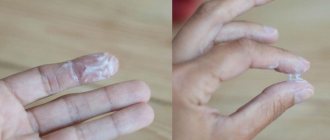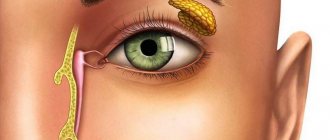Every woman has microflora in all mucous membranes, including the vagina. If she is healthy, then the woman feels good, nothing bothers her. But then she notices a white discharge of a cheesy consistency with a noticeable sour smell, accompanied by itching and swelling of the vagina... She understands that she has developed thrush. And when bloody discharge also occurs with thrush, most women get scared, become confused and do not know what this is connected with. The best option in this case would be to immediately visit a gynecologist, since there can be many reasons for the appearance of blood.
How to understand where is the norm and where is the pathology?
The subtlety in diagnosing thrush is that it is caused by a fungal infection. In medical terms, it is caused by yeast fungi belonging to the genus Candida. The nuance is that these microorganisms also live in the body of healthy women and men. They live in the microflora of the mouth, vagina and large intestine. In small quantities, Candida mushrooms are a natural state of a healthy body. However, in some conditions they begin to multiply significantly, and in this case we can talk about the appearance of thrush or candidiasis. Moreover, discharge from the female genital tract itself is also a natural process, but only if it is not abundant and has a transparent color. For example, during ovulation (egg maturation), a woman’s discharge increases, and this is normal. But only if they are colorless or odorless can they be compared to egg white.
Prevention of thrush in hygiene
Hygienic procedures for thrush are of particular importance, since the activity of fungi can cause not only unpleasant sensations of itching and burning, but also a serious inflammatory process. When preventing candidiasis, it is necessary to use hygienic detergents that will not cause dryness, as this will lead to increased discomfort. Gynocomfort intimate gels are ideal for solving this problem. Created by specialists from the pharmaceutical company VERTEX, they have a balanced composition and do not cause discomfort. The funds have all the necessary package of documents and certificates.
Other recommendations from doctors are as follows:
- When choosing underwear, you need to focus exclusively on natural cotton materials. Underwear made from such fabric ensures normal air exchange, while synthetics do not allow air to pass through well and can cause sweating and increased temperature, which will create favorable conditions for the growth of fungus.
- When using lubricants, you should give preference to water-soluble formulations. They will not affect the microflora and cause an increase in the number of opportunistic fungi. Also, if you experience irritation from using latex condoms, you should try more neutral polyurethane products.
- Hygienic procedures must be performed once or twice a day. It is worth remembering that both infrequent hygiene procedures and too frequent use of products for the care of the intimate area can worsen the condition of the microflora of the intimate area. Here the issue of proper selection of hygiene products becomes very relevant. It is better if they have the properties of preventing the occurrence of candidiasis.
Expert opinion
To prevent candidiasis, vaginal douching is not recommended, as it removes beneficial microflora from the woman’s genital tract, thereby creating favorable conditions for the active proliferation of Candida fungi.
Obstetrician-gynecologist of the highest category Oksana Anatolyevna Gartleb
What can yellow discharge indicate?
This type of vaginal discharge can be either a normal variant or an alarming symptom, which should definitely consult a doctor as soon as possible. This is especially true for those who have yellow discharge when thrush develops, i.e. accompanied by itching, pain, and a pungent odor.
If yellow discharge is observed, this may be a sign of: • Acute sexually transmitted infection (there can be many of them, for example - gonorrhea). •Inflammation in the uterine appendages or ovaries. •Cervical erosions.
Yellow discharge in women
What steps to take if a woman discovers yellow discharge?
There is definitely no need to panic, since only a qualified, experienced gynecologist can determine an accurate diagnosis, and only after a series of tests. You cannot draw a conclusion based on the color of the discharge alone. Therefore, you should consult a doctor and undergo basic tests, which will be prescribed by a gynecologist. In this case, it is necessary to carefully monitor yourself, lead a healthy lifestyle and regularly carry out personal intimate hygiene. In addition, science knows that Candida fungi feed on yeast products and sweets. Therefore, it is strongly recommended to exclude chocolate, cookies, cakes and other confectionery products from your diet. This must be done at least before the diagnosis is clarified and test results are received. It is also known that in some cases, active reproduction of Candida during thrush can be caused by decreased immunity. With thrush, immunity drops sharply and yeast fungi can multiply unhindered. Therefore, you should try to improve your immunity, but use only classic “folk” remedies until you receive an accurate diagnosis. This means active consumption of vitamins, adequate sleep, and physical activity. However, if the cause of the detected discharge is an acute infection, treatment must be started immediately, and in particularly acute cases, hospitalization may also be recommended. If thrush has already been confirmed, you should pay close attention not only to the color, but also to the consistency of the discharge. The denser they are, the higher the likelihood that the pathogen is an infection.
Treatment of chronic thrush
Chronic candidiasis is treated comprehensively. This means receiving:
- antifungal medications;
- immunostimulants;
- drugs that normalize microflora;
- vitamin complexes.
The doctor decides which drugs will be more effective based on a previous examination. If it is possible to identify a type of Candida fungus, then medications to which these fungi are sensitive are selected. Since in chronic thrush the disease affects not only the genitourinary area, long-term treatment is required. It may last for several months.
Drug therapy
The basis of treatment is an antifungal drug. It can take any form - ointments and gels, suppositories, vaginal tablets, capsules. Medicines are taken internally to rid the body of fungal colonies on other organs. This is an effective technique, which, however, is fraught with side effects, since it increases the load on the liver and urinary tract.
Local medications are designed to quickly relieve a sick person from unpleasant symptoms: discharge, itching, redness. Your doctor will determine how long to take these medications and in what dosage.
Typically, one of the following drugs is prescribed:
- Pimafucin . It contains an antibiotic that is effective against Candida fungus - natamycin. The product is available in the form of ointments, tablets, and suppositories. The main advantage of Pimafucin is safety, so it is most often prescribed to pregnant women.
- Nystatin . Perhaps the most effective remedy for recurrent thrush, since fungal strains cannot develop immunity to this medicine and die. However, it should be understood that the drug affects not only pathogenic microflora, but also beneficial ones.
- Livarol . These are vaginal suppositories containing ketoconazole. You will need a course of 10 doses to get rid of chronic candidiasis. However, the medicine has a fairly large list of side effects.
- Terzhinan . A universal drug used in the treatment of many diseases of the genital area. Suitable for treating thrush during pregnancy.
- Fluconazole . This is a capsule taken orally. The medicine is prescribed to women and men
Since exacerbation of thrush usually indicates a decrease in immunity, vitamins are prescribed in addition to drug therapy. It is especially important to pay attention to vitamins B, A, E, C. The doctor also prescribes general strengthening agents, for example, tincture of echinacea or ginseng. Since thrush is a disorder of the body’s microflora, medications are needed to restore it. For this purpose, they take Linex, Gynoflor, Acipol, etc.
Folk remedies
Chronic thrush cannot be cured with folk remedies alone, but their use is justified in some cases and doctors often recommend certain methods to their patients.
The following alternative medicine recipes are most often recommended:
- Soda - it must be added to baths and used when washing.
- Douching - infusions of various herbs are used for this. Chamomile, calendula, St. John's wort, oak bark - these medicinal herbs have anti-inflammatory and restorative effects.
- Carrot juice - you need to drink it internally, as it strengthens the immune system and increases the body's resistance to thrush. The juice is also used for douching.
Douching is dangerous during pregnancy, so it is allowed to be performed only with the consent of a doctor!
Prevention of thrush: is it possible to get rid of it once and for all?
As we already know, the causative agent of thrush lives in the body of every person. However, not everyone begins to multiply to alarming numbers. Therefore, preventive measures include an active lifestyle, a varied and healthy diet with a small amount of yeast and sweet foods. In addition, having one sexual partner or protected sexual intercourse plays an important role. For prevention, you can use a wash with chamomile or sage infusion. The healing properties of these herbs help maintain the microflora of the female internal genital organs at a healthy pH level and kill harmful microorganisms. When dealing with thrush, it is very effective to regularly carry out the above-described preventive procedures, only when you can forget about it for a long time.
How to treat thrush?
All methods of treating thrush are aimed at eliminating the symptoms and the possibility of further development of the disease if it is a urogenital type of fungal infection. The effect of treatment is achieved by using topical medications and systemic oral administration of medications. To locally eliminate signs of thrush in girls, creams, ointments, suppositories, vaginal tablets, etc. are used. Tablets and capsules are prescribed as systemic agents.
Local medications will help relieve the unpleasant symptoms of thrush, but nothing more. Taking systemic medications will help consolidate the effect and prevent relapse.
Do not neglect the recommendations of doctors, because further development of thrush and its recurrence (up to 3-4 times within a year) are fraught with complications in the future life of the woman and mother.
Popular remedies are antibacterial drugs:
- nystatin (contained in Polygynax, Terzhinan)
- clotrimazole (in Canesten, Candibene, Candizol)
- natamycin ("Pimafucin")
- ketoconazole (as part of Nizoral, Mycozoral, Livarol)
For mild cases of the disease or the initial stage of redness of the mucous membrane, one dose of fluconazole 150 mg orally is sufficient.
- Cedar barrel - indications and contraindications. The benefits of procedures in a cedar barrel sauna for weight loss and health
- Eyebrow decoration
- Wen on the face
The use of suppositories and ointments containing substances aimed at destroying broad-spectrum bacteria has a depressing effect on the vaginal flora. Therefore, a course of treatment containing immunostimulating drugs is prescribed, which must be taken strictly following the instructions.
Is yellow discharge normal or abnormal for thrush?
Candidiasis is a disease that is accompanied by the following symptoms: severe itching, burning and various types of discharge. Their nature and color most often depend on the specifics of the disease. At the initial stage, thrush appears as a small amount of thick white discharge, but as the disease progresses, the amount increases and the color can vary from greenish-yellow to pink or brown (bloody). Yellow discharge due to thrush in women is a cause for concern and a reason to immediately consult a doctor.
In order to exclude the presence of other urinary tract infections and cervical erosion.
Traditional methods of therapy
One of the methods for treating chronic thrush in women is the use of products based on natural ingredients. Such therapy can be used exclusively as a supplement to the main course prescribed by a specialist. Among the effective recipes are:
- Dissolve five tablespoons of baking soda in warm water. Mix the mixture thoroughly and use it for a sitz bath. Carry out the procedures twice daily.
- Mix calendula, string, chamomile, sage, St. John's wort and eucalyptus in identical proportions. Steam a spoonful of the prepared mixture in a glass of boiling water and leave for about 35 minutes. Pour the infusion into a bowl of warm water and take a sitz bath for 20 minutes.
- Douching using infusions of medicinal plants will be beneficial. For these purposes, you can use chamomile, St. John's wort, oak bark or calendula.
- Grind the head of peeled onion using a meat grinder. Roll a swab from a sterile piece of gauze. Soak it in the juice squeezed from onion pulp. Insert the prepared tampon into the vagina and leave it overnight. Garlic can be used in a similar way.
- Roll up a sterile gauze pad. Soak it in natural kefir enriched with bifidobacteria. Insert the tampon into the vagina and leave it overnight. After removing it in the morning, douche using calendula decoction.
- Melt natural honey in a water bath. Roll up a swab from sterile gauze and soak it in honey. Place the tampon into your vagina and leave it overnight. After the first procedures, a burning sensation may occur. It will pass in three to four days.
- You can defeat the fungus using tar soap. They need to wash themselves daily before going to bed.
Such recipes in rare cases can provoke allergic reactions. Consult your doctor before choosing a specific prescription.
Strengthening the immune system, avoiding sexual contact with potential carriers of the pathogen, as well as careful adherence to all standards of personal hygiene will help to avoid the development of thrush. Be sure to use a condom during sexual intercourse. Get regular medical examinations and treat any identified problems. At the first symptoms of thrush, consult a doctor. This is the only way you will maintain your health.
What does this indicate: reasons
The reason for the yellowish color of the discharge during thrush is mostly due to the ingress of leukocytes into it, which, in turn, indicates an inflammatory process. Yellow discharge can be caused by vaginal dysbiosis or a number of chronic diseases, such as gonorrhea, trichomoniasis or chlamydia. In addition, any pathological discharge can be caused by external irritants (for example, uncomfortable underwear or hypothermia).
In pregnant women
Yellow discharge due to thrush during pregnancy is not normal. At this time, a woman’s body is most susceptible to yeast-like fungi and other gynecological diseases, due to hormonal changes and a decrease in the body’s immune activity.
As a result, the acidity of the vagina increases, and the environment becomes favorable for the growth and reproduction of pathogenic microorganisms. If candidiasis occurs without complications and concomitant infections, the cause of the yellow color is the predominance of an acidic environment and chemical reactions in it.
However, you should consult a specialist to conduct a full examination and identify the causes of pathological discharge, since the treatment of candidiasis during pregnancy has a number of features that should not be neglected.
Before your period
The appearance of discharge characteristic of candidiasis before the onset of menstruation indicates a sluggish inflammatory process. In other words, the infection is in a chronic stage and has not been fully treated. The activation of pathogenic fungi during this period is associated with changes in the vaginal microflora before menstruation. Its defenses are reduced, which allows the disease to progress.
IMPORTANT: the yellow color of the discharge may also indicate that, in addition to chronic thrush, there are infectious diseases in the genitourinary tract.
What causes thrush in girls?
To understand why vaginal candidiasis occurs, it is enough to understand a little about the physiology of the female body. Then everything will become simple and clear, and besides, armed with knowledge, girls can prevent cases of exacerbation of candidiasis.
During puberty, a girl's body undergoes significant changes under the influence of changes in hormone levels. The “launch” of hormonal changes occurs at the age of 10-12, it is at this time that girls begin menstruation for the first time, and at the age of 15 the level of hormones usually stabilizes. Since the entire reproductive system works as a single mechanism, the vaginal microflora depends directly on how female sex hormones influence it.
The determining hormones in this regard are estrogens. It is the hormones of this group that create an acidic environment in the vagina, in which pathogenic microflora cannot develop. As long as the estrogen level is normal, thrush should not appear.
If hormonal levels drop, the vaginal microflora is one of the first to respond to these changes. Pathogenic microorganisms, including candida fungi, simply flourish against this background and begin to actively multiply. Considering the immediate causes of thrush in girls, it is worth summing up that the leading one is hormonal imbalance.
There are also an additional number of factors that can provoke the disease for the first time or aggravate a previously existing pathology. All these factors primarily affect the amount of estrogen, after which a change in the acidity of the vaginal environment indirectly begins.
Among these factors are:
- pathology of the pituitary gland;
- thyroid diseases;
- sudden weight loss;
- the appearance of hormonally dependent neoplasms;
- treatment with hormonal drugs without taking into account individual characteristics (self-medication);
- iron and cholesterol deficiency;
- taking antidepressants and nootropics.
Each of these points is extremely important and can provoke symptoms of thrush in girls. Photos of signs of the disease on the Internet are almost in the top requests among the category of 16 years and older. The appearance of the first signs of the disease worries girls, and they want to get more information about the problem that concerns them.
Can a guy get infected?
Thrush is by no means a woman’s disease. Men also suffer from the disease, but their manifestations of candidiasis are much less pronounced than in the fair sex. In most cases, the pathology is asymptomatic, so the guy may not even be aware of his danger to his sexual partner. Infection with thrush can occur at any age, even at 17 years old, if sexual activity occurs without protection.
Why can girls get thrush from their sexual partner if their hormone levels are normal? The answer is simple - the vagina receives, in addition to its own candida fungi, which are inhibited by an acidic environment, an additional “portion” of fungi from the sexual partner. The body is unable to cope with such a volume of pathogenic microflora, which is why vaginal dysbiosis appears, i.e. thrush.
And it doesn’t matter at all whether the disease existed before, or these are the first signs of thrush - the pathological process has already started.
Where else does candidiasis come from?
You can become infected with candidiasis not only after sex with an infected sexual partner.
In addition, there are several factors that can provoke candidiasis:
- Taking antibacterial drugs is one of the common causes of vaginal candidiasis. Antibiotics can not only kill pathogenic microorganisms, but also disrupt the balance of beneficial microflora. A decrease in the number of lactobacilli due to the use of antibiotics is a direct path to an increase in the number of candida fungi.
- Poor nutrition - predominance or deficiency of fermented milk products can also provoke thrush, since the level of lactobacilli is disrupted. This is often the case with girls who follow mono-diets, such as kefir diets.
- The presence of serious diseases in the body - thrush is provoked by somatic pathologies, for example, uncompensated diabetes mellitus. Diseases of the genitourinary system are especially dangerous in relation to the occurrence of thrush.
- Gynecological manipulations - the disease can be provoked by: the first gynecological examination, early pregnancy, etc.
These factors also often cause an imbalance in the vaginal microflora, so girls need to minimize their impact on their body.
How to get rid of yellow discharge during candidiasis?
To get rid of discharge during candidiasis, complex antifungal therapy is necessary, aimed at eliminating the disease in acute or chronic form. It includes the use of general and local drugs, as well as some folk remedies to eliminate symptoms. In addition, it is necessary to seriously reconsider your lifestyle and nutrition.
Repeated appearances of thrush and the addition of secondary sexually transmitted infections indicate a malfunction of the immune system. For candidiasis, a low-carbohydrate diet, limiting the intake of alcohol, coffee, and dairy products is indicated. To eliminate the disease once and for all, you should follow all the recommendations of your doctor.
Drug elimination
There are many antifungal agents. For local treatment, vaginal ointments, creams, suppositories and tablets are the preferred choice. They can be used for the primary treatment of thrush or as part of complex therapy for chronic candidiasis. Systemic drugs are antifungal tablets for oral administration.
When choosing a treatment regimen, it is necessary to be guided by the results of a bacteriological culture analysis from the vagina, which reveals the sensitivity of pathogenic microorganisms to a specific drug. Most often, in chronic cases of thrush, fungal colonies that are resistant to antimycotic agents are identified by culture. In this case, therapy must be comprehensive.
After the course of treatment, bacteriological culture should be repeated to make sure that there is no fungus left. To restore normal microflora after illness, vaginal suppositories with lactobacilli and bifidobacteria are used. This will help quickly return local immunity to normal and reduce the risk of complications. By the way, pink discharge may remain even after treatment for thrush, this suggests that the cause was not candidiasis.
Traditional therapy
Alternative medicine is widely used in cases of chronic recurrent thrush. Folk remedies are used both for prevention and as treatment of the disease. Mostly locally!
- Douching and washing with soda solution are used to prevent relapses of the disease and as general therapy. Before each use of antifungal suppositories, it is necessary to douche. This helps reduce the amount of pathogenic microflora in the vagina and, thereby, enhance the effect of the drugs. To prepare the solution you need to: dilute 1 tablespoon of baking soda in a liter of hot water. Allow to cool to room temperature. This concentration is suitable for both douching and washing. The effect can be enhanced by adding a few drops of iodine.
- Douching and washing with herbal mixtures help eliminate the symptoms of thrush and significantly reduce itching, burning and the amount of vaginal discharge. To prepare the solution, you need to mix 1 tablespoon of herbal mixture (you can use chamomile, calendula, sage) and 0.5 liters. boiled water. Let the mixture sit for a while, then strain the contents. With this product you can douche up to 3 times a day, for a period of no more than a month.
Competent diagnostics
To make an accurate diagnosis, a medical examination of the patient is performed. The following methods are used:
- Microscopic examination of a vaginal smear. A gynecologist collects biological material from a woman. The secretion is applied to a glass slide and examined under a microscope. In the presence of chronic candidiasis, yeast-like fungi will be visible.
- Bacteriological culture. The secretion from a woman's vagina is placed in a nutrient medium. After some time, the formation of a whole colony of fungi is noted. This can happen to the image of a healthy woman. Therefore, the number of pathogens plays a key role here. The presence of thrush is indicated by the number of fungi exceeding 10,000 CFU per 1 ml.
- Study of fungus for drug resistance. This helps specialists decide how to treat the disease as effectively as possible.
Doctors often recommend conducting additional studies to determine the presence of concomitant sexually transmitted diseases. This helps eliminate the possibility of developing serious complications.
Continue after treatment: what to do?
There are cases when, in the absence of other symptoms, the discharge does not go away. It should be remembered that the cause of this may be infectious diseases that are not related to the fungus. It is important to get specialist advice in a timely manner. Reasons for increased vaginal discharge not related to thrush:
- Chronic diseases of the genitourinary system, such as: gonococcal, herpetic infections, trichomoniasis;
- Taking hormonal drugs;
- Failure to comply with nutritional recommendations during treatment of the disease;
- Hypothermia;
- Cystitis.
Protracted pathological discharge is a sign of a severe inflammatory process. To identify its causes, additional examination and laboratory diagnostics should be performed.
Complication after thrush
Harmless candidiasis can cause serious pathologies. The most common complication is cervical erosion. The structure of the mucous membrane is disrupted and ulcers appear. If candidiasis is not treated, erosion appears and other painful symptoms appear. The menstrual cycle is disrupted and problems with conception appear.
Chronic cystitis, which develops against the background of thrush, is dangerous due to infection of the kidneys. To get rid of the disease, you need to undergo serious complex treatment.
The consequence of an advanced stage of thrush is ectopic pregnancy, miscarriage, and premature birth. Fungi provoke inflammation of the genital organs, and adhesions appear in the uterine tubes.
In men, prostatitis, urethritis, and infertility develop against the background of thrush. The genital organ swells, peeling, red spots, and plaque appear. Potency suffers.
Types of discharge from thrush and what they indicate
Thrush, or candidiasis, is a common disease of the female genitourinary system. Men suffer from this infection less often, but often become carriers of the disease themselves. The causative agent of the disease is a fungus of the genus Candida, which is part of the vaginal microflora and normally does not cause pathological changes.
Unpleasant symptoms indicating the onset of an infectious process appear when Candida begins to multiply rapidly, negatively affecting the genital mucosa. Discharge from thrush in women is one of the main signs that indicate the occurrence of the disease.
Therapy program
Treatment of chronic thrush should be comprehensive. Particular attention is paid to maintaining the protective functions of the body. Only by restoring the immune system will it be possible to cope with the disease. The following therapeutic techniques are used:
- Use of medications.
- Lifestyle adjustments.
- Dieting.
A plan for how to cure chronic thrush is developed individually for each patient. Uncontrolled use of any means will lead to complications of the disease.
Use of medications
The main way to treat chronic thrush is the use of medications. Today, a large number of antimycotic drugs have been developed. They come in various forms:
- Pills. They help cope with symptoms and cure the cause of the disease. Fluconazole, Flucostat, Diflucan, Nystatin and others are more often prescribed. Such medications in tablet form are prohibited from being taken during pregnancy, as well as in case of individual sensitivity to the components of the drug.
- Creams and ointments. They have a good local effect. The components of the drug quickly penetrate to the source of infection and suppress the activity of fungi. Experts recommend using Lomexin, Nystatin, Candide and others. The cream is injected as deep as possible into the vagina several times a day.
- Candles. They are used as an adjuvant in the treatment of chronic thrush in women. The active substance quickly stops the proliferation of fungi. Clotrimazole, Macmiror, Pimafucin and others are used. Not all of them are allowed during pregnancy, so before starting treatment you must carefully study the instructions.
In addition to antimycotic drugs, experts prescribe medications that restore normal vaginal microflora. The most effective drugs are in the form of suppositories: Bifidumbacterin, Vagikal, Lactobacterin and others. They contain beneficial bacteria that suppress the activity of pathogenic microflora.
To restore the body's protective functions, immunomodulators are used. Interferon-based products are considered the most effective and safe. Only properly treated candidiasis will not lead to the development of complications.
Diet therapy
Drugs for the treatment of chronic candidiasis in women are effective only if the diet is adjusted. In this case, it is necessary to follow the basic recommendations:
- The consumption of alcohol, blue cheeses, confectionery, smoked meats and marinades is strictly prohibited. These products stimulate active growth of the fungus.
- You will also have to give up foods that contain large amounts of sugar: chocolate, jam, cakes, as well as sweet fruits and berries.
- Products containing lactose will also cause harm.
- The diet must include garlic, green onions, seafood, legumes, cereals, seeds and nuts.
- Natural yogurt enriched with probiotics will bring benefits. You can cook it yourself. All you need to do is find the right starter and stock up on milk.
- The menu should include sour berries: lingonberries, cranberries, blueberries and sea buckthorn. They can be eaten fresh or made into fruit drinks and compotes without sugar.
- Eating enough fruits and vegetables will help stimulate your immune system. Cabbage, carrots, beets, cucumbers, apples, lemons and plums are especially useful.
- Drink more clean water. You need to drink at least 1.5 liters per day. You can supplement your drinking regime with decoctions of medicinal plants: rose hips, chamomile, oregano.
Causes of discharge due to candidiasis
Normally, a woman may experience slight vaginal discharge, white or light in color, odorless. They are an individual feature of the body and do not require treatment. Physiological leucorrhoea appears when the secretion of glands located in the vulvar mucosa increases. This phenomenon occurs during pregnancy, during ovulation, before and after menstruation.
Unlike physiological leucorrhoea, pathological discharge often has a specific unpleasant odor, its quantity increases, the color of the discharge and consistency change. This indicates damage to the genitourinary system by pathogenic microorganisms and the development of an inflammatory process.
Discharge during candidiasis appears due to changes in the internal environment of the vagina, which is affected by a fungal infection. A healthy woman has a vaginal pH of 4.5. With such acidity, the microflora of the internal environment reproduces normally, providing the necessary level of moisture and protection from pathogenic bacteria. A decrease in pH level to 3.8 or below indicates an increase in the acidity of the environment. This phenomenon is characteristic of pathological processes such as candidiasis.
With thrush, increased growth of fungal flora leads to increased acidity, which negatively affects the condition of the mucous membrane. As a protective reaction, the secretion of the glands increases, the discharge becomes more abundant, it contains waste products of a fungal infection, the color and character changes. Therefore, specific leucorrhoea, which has a cheesy consistency and an unpleasant sour smell, indicates the beginning of a pathological process.
Symptoms of thrush
The presence of candidiasis can be determined by external changes and painful sensations. The symptoms are somewhat similar to sexually transmitted diseases, but have their own characteristics. The clarity of the clinical picture depends on the individual characteristics of the organism. The weaker the immune system, the more progressive the thrush.
Candidiasis is considered a women's disease, but it also affects men. The only difference is that among representatives of the stronger half of society, candidiasis is often asymptomatic, with mild manifestations, and disappears on its own as the immune system strengthens. However, you should not rely on such a favorable outcome; it may happen that candidiasis turns into an advanced, chronic form. At the first manifestations of thrush, measures must be taken.
Symptoms in women:
- cheesy thick white discharge with a sour odor;
- swelling;
- plaque;
- itching, which intensifies in the evening;
- burning;
- discomfort during urination, pain at the end;
- discomfort during sexual intercourse;
- redness;
- pain in the lower abdomen;
- general weakness;
- frequent urge to urinate, sometimes false;
- causeless headache.
A specialist can determine the presence of candidiasis by visual examination. The vaginal mucosa becomes covered with a white cheesy coating, swelling, redness, and a loose structure are observed. To confirm the diagnosis and exclude other gynecological infectious diseases, a smear is taken.
Symptoms in men:
- the discharge is thick and white;
- plaque on the head of the genital organ;
- redness, swelling;
- itching;
- pain during urination;
- false urges;
- abdominal discomfort;
- burning;
- problems with potency;
- painful sexual intercourse;
- deterioration of health.
When thrush is advanced, irritability, headaches appear, sleep is disturbed, and the temperature rises to 37 degrees Celsius. In men, in the absence of therapy against the background of candidiasis, prostatitis, infertility, and impotence develop.
What kind of discharge occurs with thrush?
The nature of the discharge that accompanies candidiasis depends on the stage of the process and the presence of concomitant diseases. The mucus secreted by the vagina can be copious, thin or creamy in consistency, with or without odor.
The color of leucorrhoea with thrush also varies depending on the nature of the process. The following types of discharge are distinguished:
- white or cream;
- transparent;
- green;
- yellow;
- pink or brown.
In addition to color, leucorrhoea with thrush differs in smell:
- without smell;
- sour;
- with a putrid odor;
- with a fishy smell.
The density of secretions during candidiasis can also be different:
Any change in the nature of the discharge, accompanied by unpleasant sensations in the genital area, is a reason to consult a gynecologist. The specialist will clarify the diagnosis using additional examination methods and prescribe treatment that is effective against the causative agent of the disease.
White discharge
White cheesy discharge during thrush, which has a sour smell, is most characteristic of the acute period of uncomplicated candidiasis. The disease develops quickly; against the background of increased secretion of the vaginal glands, a rapid growth of fungal flora is observed, which is accompanied by unpleasant symptoms:
- itching, burning in the vagina;
- hyperemia and swelling of the vulvar mucosa;
- discomfort when urinating.
Leucorrhoea initially partially covers the mucous membrane and is easily removed during hygiene procedures. They look like clear liquid or watery discharge with small white or creamy grains.
As the process develops, the secretion becomes more viscous and is fixed on the hyperemic, irritated surface in the form of a dense coating, whitish in color. When the films are removed, red, swollen mucosa is exposed, with signs of inflammation.
White flakes acquire a dense, viscous consistency, and their quantity gradually decreases. If the disease is not treated, the process enters the chronic stage, when exposure to negative factors immediately provokes an increase in the number of Candida.
Liquid whitish discharge with a sour odor and a uniform consistency is characteristic of expectant mothers. Against the background of hormonal changes during pregnancy, a change in the acidity of the vagina and an increase in the population of fungal flora are observed.
Yellow leucorrhoea
A yellowish vaginal discharge can be considered normal if there are no other symptoms of thrush. Physiological leucorrhoea is one that meets the following characteristics:
- light yellow, translucent;
- without smell;
- after drying there are practically no traces left;
- there is no burning or itching.
Yellow discharge can occur due to erosion of the cervix; in this case, the associated thrush is characterized by a specific color of the secretion and painful sensations in the pelvic area. Such leucorrhoea is accompanied by some sexually transmitted diseases, such as trichomoniasis. A change in the color of secretions due to thrush also indicates the addition of a bacterial infection, when bacterial vaginitis develops together with candidiasis.
Pregnancy
Candida fungus is always present, but it begins to act actively only under favorable conditions. There is a change in acidity in the mucous membrane, after which the fungus begins to multiply. This phenomenon is called thrush. It can also develop in a pregnant woman. The main reasons for the development of candidiasis during pregnancy include:
- the use of underwear made from synthetic artificial material, which makes it impossible for the skin to “breathe”. It is recommended to use cotton underwear.
- rough sex, which results in microcracks in the mucous membrane or infection.
- weak immune system during pregnancy.
- use of medications without prescription or supervision of the attending physician.
- lack of vitamins or other useful elements.
- poor nutrition.
- hormonal imbalance.
Bloody discharge during pregnancy is a reason to immediately consult a doctor.
A timely visit to the doctor and examination will help get rid of thrush and bear a healthy baby.
Thrush without discharge
In some cases, candidiasis develops in such a way that there is no increase in secretion. A woman is worried about itching, discomfort, a feeling of dryness and burning in the vagina. The mucous membrane is hyperemic, swelling of the vulva is pronounced, and pain when touched. The discharge is scanty, usually watery, and has no characteristic odor.
This clinical picture often leads to the fact that a woman does not suspect a fungal infection and self-medicates, increasing the number of hygiene procedures. The use of strong cleansers during washing and douching leads to irritation and further drying of the mucous membrane. Microcracks form on the walls of the vagina, where the fungus also invades. The process develops, the woman’s condition worsens. This condition can last from a week to several months, when candidiasis becomes chronic.
Effective treatment of thrush is observed when antifungal drugs are prescribed; it is impossible to stabilize the state of the vaginal microflora with the help of personal hygiene.
Advanced thrush during pregnancy
Most women experience candidiasis in the first months of pregnancy. Thrush is one of the first symptoms of conception. Immediately after fertilization, hormonal levels change and immunity decreases. Candidiasis appears even before the test shows 2 stripes.
Minor manifestations of candidiasis are easily treated with folk remedies and external antifungal drugs. In the absence of proper treatment, candidiasis begins to progress. The same situation arises if a woman suffered from chronic thrush. During pregnancy, the disease begins to progress.
The presence of pathogenic microorganisms in the vagina is dangerous not only for the health of the woman, but also for the fetus. Fungi are able to penetrate the placenta, affect the development of the fetus, and the risk of pathologies increases. The advanced stage of candidiasis is dangerous due to termination of pregnancy and miscarriage. The presence of yeast in the vagina is dangerous for the baby during passage through the birth canal. In the first days of life, a child encounters oral candidiasis.
To avoid negative consequences, it is necessary to take timely measures. If the pregnancy is planned, it is necessary to be examined before conception and treated if an increased number of pathogenic microorganisms is detected in the smear.










